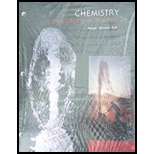
Interpretation:
The rate law and the rate constant for the gas-phase reaction of phosphine with diborane have to be determined.
Answer to Problem 13.42QE
Rate law for the given reaction is
Explanation of Solution
The reaction between phosphine and diborane to produce
Relative concentration of the reactant is determined by dividing the concentration of each reactant by the smallest concentration of the reactant. Relative rate of the reaction is determined by dividing the rate of the reaction by the smallest rate that is obtained from the experimental data.
The relative concentration of
| Experiment | Initial | Initial | Initial rate of the reaction | Relative | Relative | Relative rates of the reaction |
From the above table, it is found that in experiments 1, and 2, the concentration of diborane remains constant while the relative rate of the reaction increases in relative manner as the concentration of
From the above table, it is found that in experiments 3, and 4, the concentration of phosphine remains constant while the relative rate of the reaction increases in relative manner as the concentration of
Rate law:
Rate law is the relationship between the concentration of the reactants and the rate of the reaction. The rate law equation is given as the rate of the reaction that is directly proportional to the product of the reactant concentration that is raised to the power of the respective reactant coefficient. Therefore, the rate law for the given reaction is as follows;
Where,
Rate constant:
The rate constant for the reaction can be calculated from the rate law using the initial concentration of the reactants as shown below;
Rearranging the above equation in order to calculate the rate constant;
Substituting the values for rate and the concentration of the reactants in the above equation, the rate constant of the reaction is calculated as shown below;
Therefore, the rate constant for the reaction is
Want to see more full solutions like this?
Chapter 13 Solutions
Chemistry Principles And Practice
- 20.44 The Diels-Alder reaction is not limited to making six-membered rings with only car- bon atoms. Predict the products of the following reactions that produce rings with atoms other than carbon in them. OCCH OCCH H (b) CH C(CH₂)s COOCH མ་ནས་བ (c) N=C H -0.X- (e) H C=N COOCHS + CH2=CHCH₂ →→arrow_forwardGiven the attached data, provide the drawing for the corresponding structure.arrow_forwardno Ai walkthroughsarrow_forward
 Chemistry: Principles and PracticeChemistryISBN:9780534420123Author:Daniel L. Reger, Scott R. Goode, David W. Ball, Edward MercerPublisher:Cengage Learning
Chemistry: Principles and PracticeChemistryISBN:9780534420123Author:Daniel L. Reger, Scott R. Goode, David W. Ball, Edward MercerPublisher:Cengage Learning Chemistry: The Molecular ScienceChemistryISBN:9781285199047Author:John W. Moore, Conrad L. StanitskiPublisher:Cengage LearningChemistry: Matter and ChangeChemistryISBN:9780078746376Author:Dinah Zike, Laurel Dingrando, Nicholas Hainen, Cheryl WistromPublisher:Glencoe/McGraw-Hill School Pub Co
Chemistry: The Molecular ScienceChemistryISBN:9781285199047Author:John W. Moore, Conrad L. StanitskiPublisher:Cengage LearningChemistry: Matter and ChangeChemistryISBN:9780078746376Author:Dinah Zike, Laurel Dingrando, Nicholas Hainen, Cheryl WistromPublisher:Glencoe/McGraw-Hill School Pub Co ChemistryChemistryISBN:9781305957404Author:Steven S. Zumdahl, Susan A. Zumdahl, Donald J. DeCostePublisher:Cengage Learning
ChemistryChemistryISBN:9781305957404Author:Steven S. Zumdahl, Susan A. Zumdahl, Donald J. DeCostePublisher:Cengage Learning
 Physical ChemistryChemistryISBN:9781133958437Author:Ball, David W. (david Warren), BAER, TomasPublisher:Wadsworth Cengage Learning,
Physical ChemistryChemistryISBN:9781133958437Author:Ball, David W. (david Warren), BAER, TomasPublisher:Wadsworth Cengage Learning,





